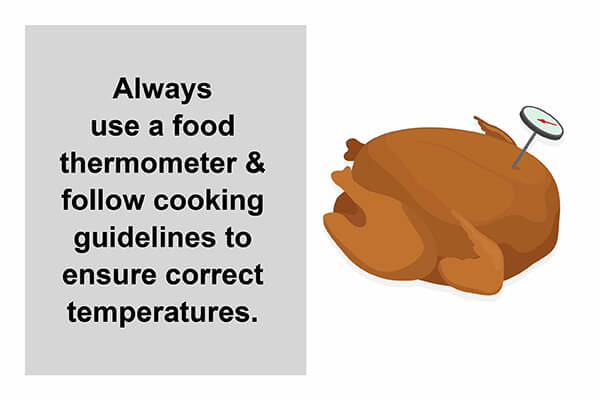November 02, 2019

Each year millions of people get sick from foodborne diseases. In many cases, these illnesses could have been prevented through proper food handling and storage techniques. Below our restaurant food suppliers share five food safety best practices for home cooks.
Restaurant Food Safety Practices for the Home Cook
Restaurant professionals go through rigorous training to learn the ins and outs of proper food safety, but what about the home cook? How do you keep your family safe from foodborne illness? What are practical food handling solutions you can implement at home?
1. Clean and sanitize
Chefs know that a clean kitchen is a safe kitchen. But what qualifies as clean, exactly? Wiping your home countertops with your favorite kitchen sponge for every task isn’t enough to keep your kitchen free of harmful bacteria.

- To kill off germs and bacteria, thoroughly wash cooking equipment in hot soapy water, before and after each use. This includes all cutting boards, dishes, countertops, and utensils. Want to ensure your cooking surfaces are up to professional kitchen standards? Make your own sanitizer solution and use it to wipe down all your surfaces between each prep job.
- Wash your hands at every stage of cooking. While this may seem like a no-brainer, many novice cooks don’t take the time to thoroughly wash their hands, or don’t wash them in between each task. Scrub your hands in warm, soapy water for at least 20 seconds. A pro tip is to slowly hum the "Happy Birthday" song to yourself twice while soaping up. If you’re done washing before you finish singing, this means you haven’t properly killed off any potential bacteria.
- Properly wash your fruits and vegetables to prevent illnesses like norovirus. Germs and bacteria can live in the soil where produce is grown, so rinsing organic matter from your vegetables is imperative.
2. Rules of separation
Cross contamination, the transfer of bacteria between objects, is responsible for many cases of foodborne illnesses. In a professional kitchen, chefs take steps to avoid cross contamination. Every home cook can easily put these restaurant practices in place.
- Always keep raw meat away from other food. Store your beef, poultry, fish, and eggs separately from fresh produce. The standard rule of thumb is to organize your fridge based on cooking temperatures. Meats that require the highest internal temperature, like raw poultry, should be kept on the bottom shelf, while those with a lower cooking temp should be stored above.
- Designate non-porous cutting boards for raw meat and fish, and other cutting boards for fruits and vegetables. It helps to have a color-coded set so you can easily identify which board is for which ingredient: green for fruits and veggies, red for raw beef, yellow for poultry, etc.
- Discard any marinades and spice rubs that have been used on raw foods. Reusing ingredients that have touched raw meat can transfer harmful bacteria.
3. Proper cooking temperatures
To destroy any dangerous germs and bacteria, it’s necessary to cook food to the proper internal temperature.
Fresh beef, veal, pork, and lamb: 145°F
Poultry: 165°F
Precooked pork and ham: 165°F
Ground meat (and meat mixtures):
- Beef, pork, veal, and lamb 160°F
- Turkey and chicken 165°F
Always use a food thermometer and follow these cooking guidelines to ensure correct temperatures.
4. Stay away from the Danger Zone
Bacteria and germs rapidly multiply in the temperature range of 40°F to 140°F. Culinary professionals refer to this as the Danger Zone and have a series of practices to keep food out of this range. Here are some simple cooling and thawing techniques any home cook can use to prevent food poisoning.
- Never place hot food directly into your fridge or freezer. Doing so can raise the ambient temperature and cause other foods to reach the danger zone.
- Refrigerate or freeze foods within two hours after cooking or after buying from your store. To ensure your food is maintained at safe temperatures during transport employ “cold chain” methods and keep your food chilled during your drive home.
- Never thaw foods on your kitchen counter. Instead, thaw them in the fridge, in the microwave, or in your sink under cold, running water.

5. Clean your fridge weekly
Even after you’ve followed all the proper guidelines, food that is stored too long in your home fridge isn’t safe to eat. The general rule is to freeze or discard any cooked leftovers within four days, and one to two days for raw meats and poultry. For more thorough info on the longevity of cooked and raw foods, consult this guide.
Your Neighborhood Wholesale Restaurant Supply Store
At US Foods CHEF'STORE, our focus is providing top quality products at consistently competitive price points for restaurateurs and home cooks alike. Come visit one of our convenient locations to stock up on the best products, from produce and meats, to cleaning supplies, to professional kitchen utensils.
Wondering if purchasing bulk foods is a good choice for your family? Here we share nine healthy foods you should pick up at your local wholesale food store. Learn more and check out the recipes we’ve included!